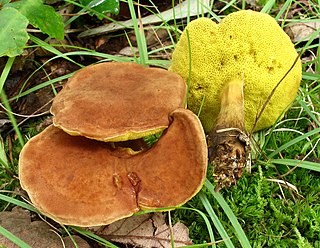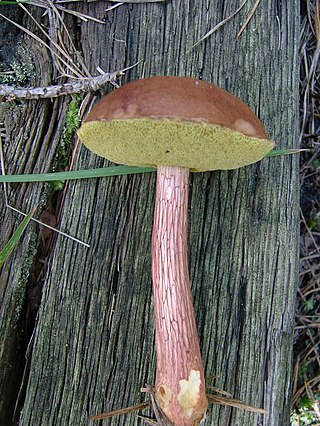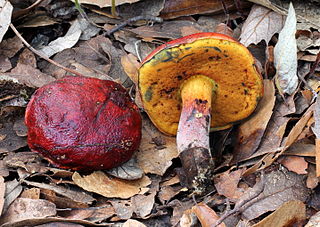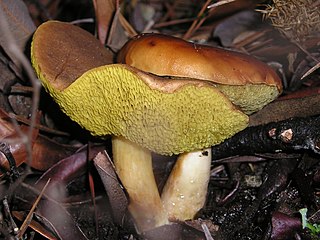
The Boletaceae are a family of mushroom-forming fungi, primarily characterised by small pores on the spore-bearing hymenial surface, instead of gills as are found in most agarics. Nearly as widely distributed as the agarics, the family is renowned for hosting some prime edible species highly sought after by mushroom hunters worldwide, such as the cep or king bolete . A number of rare or threatened species are also present in the family, that have become the focus of increasing conservation concerns. As a whole, the typical members of the family are commonly known as boletes.

Suillus is a genus of basidiomycete fungi in the family Suillaceae and order Boletales. Species in the genus are associated with trees in the pine family (Pinaceae), and are mostly distributed in temperate locations in the Northern Hemisphere, although some species have been introduced to the Southern Hemisphere.

Butyriboletus regius, commonly known as the royal bolete or red-capped butter bolete, is a basidiomycete fungus of the genus Boletus found in China and Europe. B. regius has a pink cap, yellow flesh, and a reticulate pattern on the stem. Harry D. Thiers described a similar mushroom from California as B. regius, though it is not the same species. B. regius in Europe does not stain when exposed to air, or stains weakly, but the California species stains blue. Both European and California species are considered choice edibles.

Aureoboletus innixus is a species of bolete fungus in the family Boletaceae. Found in eastern North America, it was first described scientifically by Charles Christopher Frost in 1874, from collections made in New England. An edible mushroom, the convex cap grows to 3–8 cm (1.2–3.1 in) wide and is dull reddish brown to yellow brown. The stem is 3–6

Xerocomus illudens is a species of bolete fungus in the family Boletaceae. Described as new to science in 1898, it is found in Asia and North America, where it grows in a mycorrhizal association with oak.

Boletus carminiporus is a species of bolete fungus in the family Boletaceae. Described as new to science in 1998, the species is found in the southern United States where it grows in a mycorrhizal association with various trees in mixed forests.

Boletus miniato-olivaceus is a species of bolete fungus in the family Boletaceae. Described as new to science in 1874, it is found in eastern North America and northeast Mexico.

Aureoboletus projectellus is a species of bolete fungus in the family Boletaceae. Found in North America, and recently in Europe, it grows in a mycorrhizal association with pine trees.

Phylloporus leucomycelinus is a species of bolete fungus in the family Boletaceae. First described in 1978, it is found in eastern North America and the Philippines.

Rubroboletus dupainii, commonly known as Dupain's bolete, is a bolete fungus of the genus Rubroboletus. It is native to Europe, where it is threatened, and red listed in six countries. It also occurs in North America, although it is rare there. It was first recorded from North Carolina, and then from Iowa in 2009. It was reported from Belize in 2007, growing under Quercus peduncularis and other oaks.

Butyriboletus roseopurpureus is a species of fungus in the family Boletaceae. Found in eastern North America, it was officially described in 2000 as a species of Boletus, and transferred to the genus Butyriboletus in 2015.

Chalciporus pseudorubinellus is a bolete fungus of the family Boletaceae. It is found in North America and Central America.
Butyriboletus peckii is a fungus of the genus Butyriboletus native to eastern North America. It was first described by Charles Christopher Frost in 1878. Until 2014, it was known as Boletus peckii. Recent changes in the phylogenetic framework of the Boletaceae prompted the transfer of this species, along with several other related boletes, including Caloboletus calopus, to the genus Caloboletus. In 2015, Kuan Zhao and colleagues published analysis that demonstrated that the bolete belongs to Butyriboletus, closely related to Butyriboletus pulchriceps.

Tylopilus rhoadsiae, commonly known as the pale bitter bolete, is a bolete fungus in the family Boletaceae native to the eastern United States.

Butyriboletus is a genus of fungi in the family Boletaceae. The genus was circumscribed in 2014 by mycologists David Arora and Jonathan L. Frank to accommodate "butter bolete" species that were shown by molecular analysis to be phylogenetically distinct from Boletus. Butyriboletus contains 24 ectomycorrhizal species found in Asia, Europe, North America and north Africa.

Austroboletus subflavidus is a species of bolete fungus in the family Boletaceae. It is found in eastern North America, where it fruits near oak and pine trees. Originally described as a species of Tylopilus by American mycologist William Murrill in 1938, it was transferred to the genus Austroboletus by Carl B. Wolfe in 1980. The fruit body has a white to yellowish convex to flattened cap measuring 3–10 cm (1.2–3.9 in) in diameter. The pores on the cap underside, which measure about 1 mm wide, are initially white to grayish before becoming pinkish. The coarsely reticulate and pitted stipe measures 4.5–14.5 cm (1.8–5.7 in) long by 0.7–3 cm (0.3–1.2 in). The spore print is reddish brown; spores are spindle-shaped (fusoid) with dimensions of 15–20 by 6–9 μm.

Caloboletus is a fungal genus in the family Boletaceae. It was circumscribed by Italian mycologist Alfredo Vizzini with Caloboletus calopus as the type species. The erection of Caloboletus follows recent molecular studies that outlined a new phylogenetic framework for the Boletaceae. Boletus peckii was also transferred to this genus by Vizzini, but was subsequently moved to the genus Butyriboletus based on molecular evidence. The generic name Caloboletus, derived from the Greek calos "nice", refers to the attractive red coloring of the stipe.

Boletus amyloideus is a rare species of bolete fungus in the family Boletaceae. It was described as new to science in 1975 by mycologist Harry D. Thiers, from collections made in California. It fruit bodies have a convex to somewhat flattened reddish-brown cap measuring 3–6 cm (1.2–2.4 in) in diameter. The pore surface on the cap underside is bright yellow, with small angular pores and tubes measuring 4–8 mm long. The spore print is olive-brown; basidiospores are smooth, amyloid, spindle shaped to ellipsoid, and have dimensions of 13–16 by 4.5–5.5 µm. The bolete is known only from coastal California, where it grows on the ground in mixed forests. Its edibility is unknown.

















